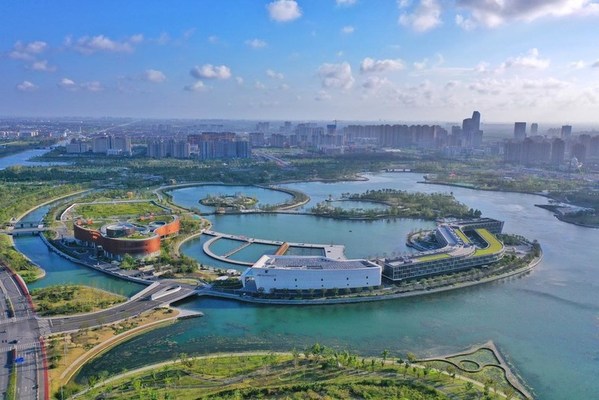SHANGHAI, Nov. 30, 2021 /PRNewswire/ -- In the booming development of five new towns in Shanghai, Fengxian will focus on promoting a plan to highlight riverside views in the next five years, reconstructing a waterfront economic vitality area and creating a new model of developing a new city out of an ancient town. The goal is to form a new water town district with a winding canal, a time-honored ancient town featuring riverside views and bustling night life, according to Shanghai Fengxian Converged Media Center.

Fengxian's new water town features a winding canal and ancient district alongside riverside views and a bustling night life.
According to conceptual planning, the landscape will include Fengxian New Town, three historical features protection areas (Zhuanghang Nanqiaotang, Qingcun Port and Fengcheng Old Town) and both sides of the canal in five towns (Zhuanghang, Nanqiao, Qingcun, Fengcheng and Situan).
It will integrate the existing water system, agricultural and forestry elements, and the cultural remains of ancient water towns to create a waterfront space featuring modern water towns. These towns will combine waterfront economy, waterfront culture and water transportation to stimulate the vitality of both sides of the canal.
Punan Canal, excavated since 1958 and with a total length of 39 kilometers, is the axis connecting Fengxian's towns, and also the historical and cultural context nurturing Zhuanghang, Nanqiao, Qingcun, Fengcheng and other ancient towns.
Zhuanghang got the name because Zhuang's family moved in and set up cotton and rice shops in the 1360s. The Zhuanghang Old Street, which is more than 1,000 meters long and full of water town charm, is a well-preserved architectural street with styles of Ming and Qing dynasties in Fengxian.
Nanqiao is the most important town of Fengxian. Although today's visitors may no longer be able to imagine the appearance of Nanqiao as an ancient water town, the urban texture of crossing rivers and streets and the historical relics such as Dingfeng pickle plant, Bulede Temple and Shenjia Garden still exude the ancient cultural elements.
Qingcun gradually became a fishing village at the beginning of the Song Dynasty and was also known for its developed salt industry. Today's Qingxi old street, Nanhong Bridge, Yongshou Bridge and Jifang Bridge span the north and south of Qingxi River. Stilted buildings, horsehead walls, carved window mullions and streets and alleys featuring stone slabs all reflect the elegance of the ancient town.
Fengcheng became Fengxian County in 1731, and was gradually referred to as Fengcheng for short. The streets in the county are cross-shaped, with Confucian Temple, Guan Yu Temple, Chenghuang God Temple, Wanfo Temple, Yanzi Temple, Zhaowen Academy, Kuixing Pavilion, Tongshan Hall and Xiannong Altar scattered among them.
Punan Canal has become an important axis for Fengxian's future development, as well as the main bank line of the plan.
Previous: Come to Dalian to experience "New Future"
Next: Trip.com Group Ltd. to Report Third Quarter of 2021 Financial Results on December 15, 2021 U.S. Time